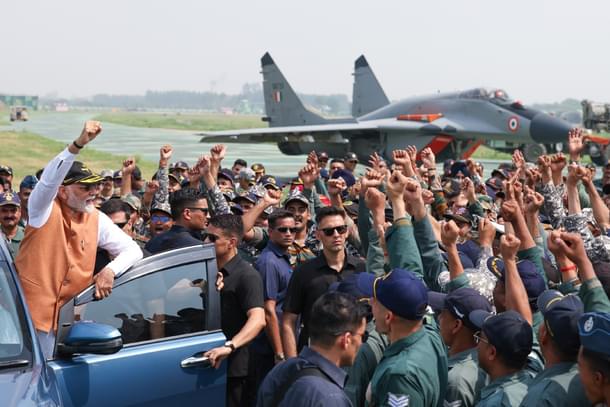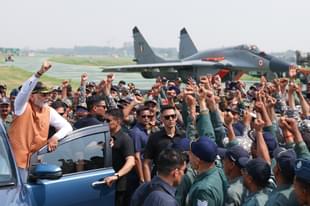Defence
One Month Of Operation Sindoor: This Pause Is Just A Pause
Venu Gopal Narayanan
Jun 07, 2025, 04:47 PM | Updated Jul 01, 2025, 09:25 AM IST
Save & read from anywhere!
Bookmark stories for easy access on any device or the Swarajya app.


It is one month since the Indian armed forces launched Operation Sindoor, a punitive strike on terrorist infrastructure in Pakistan and parts of Kashmir which it occupies, for the horrific terrorist attack at Pahalgam on 22 April. The action culminated in a ‘pause’ on 10 May, after Indian missiles destroyed Pakistani military aircraft in the air and on the ground, and furiously pounded numerous Pakistani air bases, command-and-control centres, and strategic sites, without hindrance.
Capitulation was swift once the Pakistanis realized that their offensive weapons were not only unable to penetrate the Indian air defence shield, but even worse, that their Chinese-supplied air defence systems were utterly incapable of resisting assaults by the Indian armed forces.
Hence, a desperate plea for a pause. But make no mistake: this pause is only a hiatus between two provocations by Pakistan, as it hurries to rearm and recalibrate with a vengeance. And the next time round, they are going to be better prepared.
No doubt, we have hurt them hard, but they are not going to sit still; they are shrewd, survival-oriented, and will move mountains to regroup because Operation Sindoor has demonstrated that the very existence of Pakistan as a sovereign state now hangs by a fraying thread. As explained earlier, an internal economic decay which is eating away at their ability to prosecute a full, conventional war is only compounded by their truly congenital inability to make peace with India.
To top it all, Pakistan is too central to Chinese strategic planning vis-à-vis India to be allowed to fail. Consequently, China too will now go out of its way to ensure that its ‘Iron Brother’ is better prepared for a second round. It has to, because if Pakistan fails, then the entire military might of India will be focused on a single front, the Chinese border. And if that happens, then Beijing’s hold over Tibet becomes a function of Indian whim.
The pity is that Pakistan can seek to achieve some sort of near-parity only low down on the escalation ladder, and even those rungs have been lowered by the pummelling Pakistan received on 10 May. Nevertheless, since desperation is its own master, and the stakes are too high for both countries, it is inevitable that China will aid Pakistan in numerous ways. What might some of those ways be?
First, we can expect a policy shift in Beijing, with Pakistan being supplied top-of-the-line systems and platforms, rather than the hand-me-downs Pakistan has hitherto been operating (partially out of fear that the Americans and the Indians would somehow find out their true capabilities). But now, after Operation Sindoor, with Chinese missiles having been recovered intact on Indian soil, and the severe limitations of Chinese air defence systems having been shown up, the secret is out; and along with that, the old rationale for limiting what might be supplied to Pakistan.
Second, it is highly probable that China will teach Pakistan how to kill India’s premier air defence system, the Russian-built S400. China knows because it too purchased the S400 from Russia some years ago. There are two reasons why China would be willing to share this knowledge. One, because it would greatly strengthen Pakistan’s future combat and allow it to hurt India more critically; and, two, because China does not need to keep this knowledge private because it has fielded, or is in the process of fielding, a more advanced system (possibly the HQ-19) than the S400.
For Pakistan, this would be a godsend because, as things stand, the Chinese HQ9 system it currently operates proved wholly incapable of stopping a supersonic cruise missile like the BrahMos; nor was it able to penetrate the Indian defensive shield to take out an S400.
By corollary, the lessons for India here are principally twofold: further strengthen its existing air defence systems, and accelerate the development and deployment of its own homemade, even more advanced air defence system. This is Project Kusha, and it is expected to be operational in two to three years.
Third, if China supplies the HQ19 to Pakistan, not only will the probability of countering the BrahMos go up (by an unknown factor), but it will limit Indian air combat options, and place greater strain on Indian offensive ballistic missile systems because of the HQ19’s reported ability to take out such missiles in mid-course. In fact, the HQ19’s design actually includes a satellite-killing feature, so the threat is real.
Fourth on the menu is the KJ-500 AWACS (airborne early warning and control plane). It is a top-flight platform, and more advanced than the Saab Erieye which is in service with the Pakistani Air Force at present.
As it is, the Erieye is a major threat to the Indian Air Force, and deserves to be taken out at the start of any conflict because of its dual function: detecting threats in advance and guiding missiles fired passively by jets to their targets. To explain, the AWACS identifies an enemy fighter jet far beyond visual range, instructs one of its warplanes to launch an air-to-air missile at the target with the missile’s seeker switched off, and guides the missile to the target zone. Now, close up, when the missile switches on its seeker, it is too late for the target to evade or escape because it is already trapped within the missile’s kill zone.
This is called a long-range air-to-air kill chain or a precision coordinated engagement, and an entry of the KJ-500 into the battlespace will only further burden us.
Fifth is a slew of new Chinese missiles which Pakistan does not yet possess. The list includes the PL-17 air-to-air missile with a reported range of 300–500 kilometres; the HN-2000 and CJ-10 land attack cruise missiles.
There is nothing comparable to the PL-17 in the Indian arsenal at present, although the Astra Mk-3 (codenamed ‘Gandiva’), currently under development, will be a world-beater once it enters service. Similarly, the entry of these new Chinese cruise missiles would impose a greater burden on our air defence networks (which brings us back to the point of accelerating Project Kusha).
Sixth, while Indians routinely and disparagingly call the Pakistani Navy nothing more than ‘a coastguard with submarines’, the sniggering would stop instantly if the Chinese supplied the YJ-12 supersonic cruise missile to Pakistan. Today, Pakistan operates ‘only’ the CM-302, an export version with a reported range of 280 km. But the YJ-12’s declared range is 500 km. That would upset our military planning. Also, bear in mind that their installation would not be very difficult since these missiles are modular.
Seventh, finally, is the recent online chatter that China will supply 40 stealth fighter jets of the Shenyang J-35 model to Pakistan. Whether this is merely kite-flying to boost the Pakistani people’s morale following the walloping they got from India or not, it is an eventuality which has to be considered as plausible. As it is, there are more than 300 Chinese J-20 stealth fighter jets already in service, and they pose a considerable threat to India. More, so much closer to our border, would only further encumber our military planners.
No doubt, there are ways to counter stealth, and India possesses some of them, like the new Surya VHF radar announced recently, but in the final analysis, when push comes to shove, the most effective counter to stealth is still stealth. And that is a gap which India will not satisfactorily fill for some years to come, until we develop our own next-generation stealth fighter jet.
Thus, without seeking to give gratuitous advice to the Indian government, because they know this better than us, and rather to enlighten readers, our requirements fall in three categories.
In the short term, the Indian armed forces would have to devise new deceptions and ruses, with more emphasis on precision coordinated engagements. And then, there is the strongest weapon of all in our quiver, still patiently seated on the sidelines, the Indian Navy. It would come into play in round two.
In the mid-term, we can expect strong emphasis on heavily bolstering our air defence systems, improving our air-to-air and air-to-ground combat capabilities (with the swift induction of the Astra Mk-3 Gandiva and the Rudram Mk-3 missiles respectively), and next-generation missile approach warning systems currently under development in India.
In the long term, it is everything, from hypersonic missiles, to main battle tanks, to the cutting-edge Uttam radar, to Project Kusha, and more. Indigenization of our weapons platforms and systems has to remain an article of faith, pursued with Arjuna-like focus because whether this ongoing pause ends in weeks, months, or years is merely a matter of detail. It will end because this story has only one ending.
With inputs from @Firezstarter1
Venu Gopal Narayanan is an independent upstream petroleum consultant who focuses on energy, geopolitics, current affairs and electoral arithmetic. He tweets at @ideorogue.





